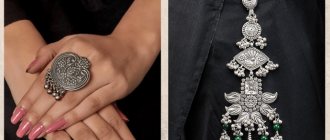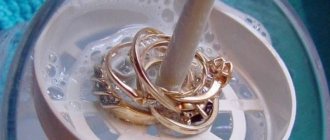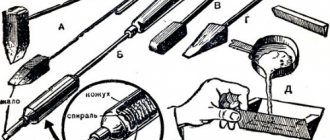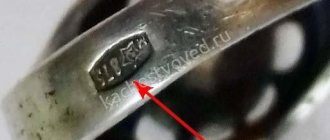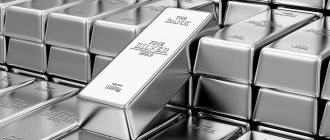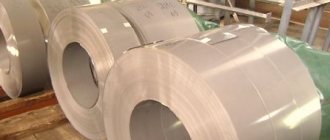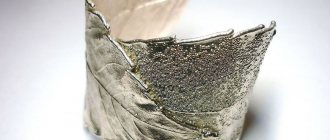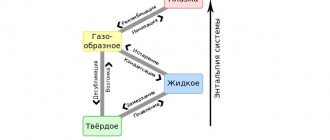How do acids interact with silver?
Silver is chemically inactive, so it belongs to the family of noble metals. In the air, silver (as a chemical substance) practically does not oxidize, does not interact with water, and is an inert metal. Under normal conditions, silver reacts weakly with various acids. This is explained by the fact that in the electrochemical series it comes after hydrogen. Silver does not react chemically with hydrochloric and dilute sulfuric acid.
Silver is oxidized by reaction with hot concentrated sulfuric acid and hydrochloric acid in the presence of free oxygen. Silver can react chemically with acids that exhibit oxidizing properties, that is, contain oxygen.
The properties of silver, weak interaction with acids, are actively used in production:
- silver dishes,
- silver spoons and forks,
- silver jewelry,
- silver coins, awards and badges.
Silver is resistant to many cold and hot acids, alkalis and salt solutions, as well as a number of organic compounds. Cold hydrochloric acid acts slowly on silver by forming an insoluble film of silver chloride.
In this article we will look at the following chemical reactions:
- reaction of silver and hydrochloric acid;
- reaction of silver and sulfuric acid;
- reaction of silver and nitric acid.
Method for producing high-purity silver nitrate
The method can be used for the synthesis of silver compounds. Silver nitrate of high purity is obtained by evaporating a solution of silver nitrate, heating the solution and introducing a salting out agent - concentrated nitric acid - in a volume ratio of a solution of silver nitrate: nitric acid 1: 0.5-0.7, the salting out agent is introduced into a previously evaporated saturated heated to 95 ± 5°C silver nitrate solution containing silver nitrate in an amount of 75-90 wt.%, after which crystallization is carried out by cooling the solution to a temperature of ≤20°C without stirring, followed by holding for 2 hours. The technical result consists in increasing the yield of the product to obtain silver nitrate of high purity. 3 ave.
The invention relates to the field of synthesis of silver compounds, namely to a method for producing high-purity silver nitrate.
Silver nitrate is the starting material in the synthesis of many other silver compounds, the production of metallic silver and materials based on them that have valuable properties [Patrushev V.V., Ryumina A.I., Vostrikova I.M. / Chemistry and metallurgy of silver / Textbook for universities in specialty 110200 “Metallurgy of non-ferrous metals”. Krasnoyarsk. 2004 - 80 p.].
There are a number of known methods for producing silver nitrate. Their essence boils down to the dissolution of metallic silver in nitric acid, followed by purification of the resulting solutions from impurities and crystallization of the product.
A method is described for purifying silver nitrate solutions obtained by dissolving crude metal from microimpurities of easily hydrolyzed heavy metals. The essence of the method is the treatment of solutions containing 900-1100 g/l of silver with silver oxide used as a sorbent at room temperature to a pH value of 5.4-6.2 for 15-30 minutes. The solution purified by filtration is sent for crystallization of silver nitrate [a.s. USSR 174789, IPC C22b, publ. 09/07/1965, bulletin. No. 18. Amaryan A.P., Bazilevsky V.M., Galankin I.I.]. Silver oxide can also be used to purify these solutions in several stages with the sequential introduction of a reagent into the solution, first to a pH value of 5.1-5.8 and separation of the first precipitate of impurities, and then to a pH of 5.9-6.3 [USA patent 3,554,883, Gerald R. Green, Rochester NY Patented 01/12/1971]. The disadvantage of this method is that it is possible to purify silver solutions only from impurities that are easily hydrolyzed in the specified pH range, and the degree of purification is low. In addition, the method does not allow the purification of silver nitrate solutions from microimpurities of elements such as Pb, Ni, Zn, Cu.
In order to increase the degree of purification of silver nitrate solutions from trace impurities of easily hydrolyzed heavy metals and to ensure the possibility of simultaneous purification from trace impurities of lead, iron, arsenic, bismuth and tin, it is proposed to pass AgNO3 solutions through a layer of oxidized coal at pH 1.5-4.0 with subsequent separation of AgNO3 by crystallization [a .With. USSR 664665, IPC B01D 15/04, C01G 5/00, publ. 05/30/79, bulletin. No. 20. Lichkova A.F., Musikhina S.F.]. However, this method is complicated by the need for periodic coal regeneration operations.
The closest technical solution is to obtain silver nitrate [a.s. USSR 504705, IPC C01G 5/00, C01B 21/48, publ. 1976. Serebrennikova G.M., Shvarts M.M., Stepin B.D., Ryazanov A.I., Serebryakova L.N., Bromberg A.V., Sazikova L.A.], in which, for the purpose To simplify the purification process and increase the purity of silver nitrate, a method for crystallizing silver nitrate by “salting out” it from solutions with concentrated nitric acid has been proposed. The basis of the method is the extremely low solubility of AgNO3 in this solvent. Concentrated nitric acid is added to an aqueous solution containing 60-66% silver nitrate at room temperature at a rate of 100-120 ml/h at a ratio of silver nitrate solution:nitric acid equal to 1:0.5-0.7. The released AgNO3 crystals are separated from the mother liquor and dried at a temperature of 100°C. The silver nitrate obtained by this method meets the GOST requirements for reagent grade qualification.
The disadvantage of this known method is the relatively low yield of silver nitrate - 88% in the form of a wet product. Naturally, for a dried product the yield value will be even lower, however, without data on the moisture content of the resulting silver nitrate, it is not possible to accurately estimate it.
The technical result to be achieved by the proposed method for producing silver nitrate is to increase the yield of the product to obtain silver nitrate of high purity.
This technical result is achieved by the fact that the method for producing high-purity silver nitrate, including evaporation of a silver nitrate solution, heating the solution and introducing a “salting out agent” - concentrated nitric acid - in a volume ratio of silver nitrate solution: nitric acid 1: 0.5-0.7, is also characterized in that the “salting out agent” is introduced into a pre-evaporated saturated solution of silver nitrate heated to 95±5°C, containing silver nitrate in an amount of 75-90%, after which crystallization is carried out by cooling the solution to a temperature of ≤20°C without stirring, followed by holding within 2 hours.
The essence of the invention is that the “salting out agent” - nitric acid - is introduced into a solution heated to 100°C and pre-evaporated to a silver nitrate content of 75-90% (wt.), the mixture is cooled without stirring to a temperature of ≤20°C and kept her within 2 hours. The obtained technical result, which consists in increasing the yield of the product, is achieved due to the fact that the “salting out agent” - concentrated nitric acid - is introduced into a hot solution of silver nitrate, previously evaporated to a state close to saturation. Under such conditions, in the presence of a salting out agent, the solubility of silver nitrate decreases significantly, and upon cooling, crystallization of the product occurs more completely.
The method for producing high-purity silver nitrate consists in preliminary washing of refined silver with a purity of at least 99.99% with a 1% ammonia solution and water until a neutral reaction, dissolving the wet powder in hot nitric acid, taken in a volumetric ratio of nitric acid:water equal to 1:1. After complete dissolution of silver, the solution is evaporated to a silver nitrate content of 75-90% wt., which corresponds to obtaining a solution close to saturated in silver nitrate content (the solubility of silver nitrate is 90% at 100°C. Pyatnitsky I.V., Sukhan V. V. Analytical chemistry of silver (M.: Publishing house Nauka, 1975).
A “salting out agent” is introduced into a hot solution (95±5°C) - concentrated 70% nitric acid, taken in a volume ratio of silver nitrate solution: nitric acid 1: 0.5-0.7. The resulting mixture is cooled without stirring to a temperature of ≤20°C and maintained at this temperature for 2 hours for more complete crystallization of the product. The pulp is filtered, the silver nitrate precipitate is washed with small portions of concentrated nitric acid and the AgNO3 crystals are dried at a temperature of 100°C for 3 hours. The final product is silver nitrate, which, in terms of the content of the main substance, water-insoluble impurities and other indicators, meets the requirements of GOST 1277-75 for the “reagent grade” qualification. The resulting method provides a product yield of 93.0-93.6%.
The present invention is illustrated by the following examples.
Example 1
1 kg of refined crystalline silver, pre-washed in a 1% solution of ammonia and water, was dissolved by heating in 1.5 l of 35% nitric acid. The content of impurities in the solution was, mg/l: Fe - 14.53; Cu, Bi, Pb - <5; Cl- - 1.84; SO 4 2 − — 16.07.
The silver nitrate solution was evaporated to a volume of 1 l, and the concentration of silver nitrate was 75% wt. A “salting out agent”—concentrated 70% nitric acid, taken in an amount of 0.5 liters—was introduced into the hot solution (95°C). The resulting mixture was cooled to a temperature of 20°C without stirring and the mixture was kept at this temperature for 2 hours for more complete crystallization of the product. The silver nitrate precipitate was filtered, washed with small portions of concentrated nitric acid (2 times 25 ml), and the AgNO3 crystals were dried at 100°C for 3 hours. After purification using the proposed method, the content of impurities in the crystals did not exceed, %: Fe - 0.0002; Cu - 0.0005; Pb, Bi - 0.0005. In terms of the content of the main substance (99.9%), water-insoluble impurities and other indicators, the resulting product meets the requirements of GOST 1277-75 for the “reagent grade” qualification. The mass of dry silver nitrate was 1.465 kg, which corresponds to its yield of 93.0%.
Example 2
1 kg of refined crystalline silver, pre-washed in a 1% solution of ammonia and water, was dissolved by heating in 35% nitric acid. The content of impurities in the solution was, mg/l: Fe - 14.53; Cu, Bi, Pb - <5; Cl- - 1.84; SO 4 2 − — 16.07.
The silver nitrate solution was evaporated to a silver nitrate concentration of 90% wt. A “salting out agent”—concentrated 70% nitric acid, taken in an amount of 0.7 liters—was introduced into the hot solution (100°C). The resulting mixture was cooled to a temperature of 20°C without stirring and the mixture was kept at this temperature for 2 hours for more complete crystallization of the product. The silver nitrate precipitate was filtered off, washed with small portions of concentrated nitric acid (2 times 25 ml each), and the AgNO3 crystals were dried at 100°C for 3 hours. After purification using the proposed method, the content of impurities in the crystals did not exceed, %: Fe - 0.0002; Cu - 0.0005; Pb, Bi - 0.0005. In terms of the content of the main substance (99.9%), water-insoluble impurities and other indicators, the resulting product meets the requirements of GOST 1277-75 for the “reagent grade” qualification. The mass of dry silver nitrate was 1.465 kg, which corresponds to its yield of 93.6%.
Example 3
1 kg of refined crystalline silver, pre-washed in a 1% solution of ammonia and water, was dissolved by heating in 35% nitric acid. The content of impurities in the solution was, mg/l: Fe - 14.53; Cu, Bi, Pb - <5; Cl- - 1.84; SO 4 2 − — 16.07.
The silver nitrate solution was evaporated to a silver nitrate concentration of 90% wt. A “salting out agent”—concentrated 70% nitric acid, taken in an amount of 0.6 liters—was introduced into the hot solution (98°C). The resulting mixture was cooled to 18°C without stirring and the mixture was kept at this temperature for 2 hours to ensure more complete crystallization of the product. The silver nitrate precipitate was filtered, washed with small portions of concentrated nitric acid (2 times 25 ml), and the AgNO3 crystals were dried at 100°C for 3 hours. After purification using the proposed method, the content of impurities in the crystals did not exceed, %: Fe - 0.0002; Cu - 0.0005; Pb, Bi - 0.0005. In terms of the content of the main substance (99.9%), water-insoluble impurities and other indicators, the resulting product meets the requirements of GOST 1277-75 for the “reagent grade” qualification. The mass of dry silver nitrate was 1.465 kg, which corresponds to its yield of 93.3%.
A method for producing silver nitrate of high purity, including evaporation of a solution of silver nitrate, heating the solution and introducing a salting out agent - concentrated nitric acid - in a volume ratio of a solution of silver nitrate: nitric acid 1: 0.5-0.7, characterized in that the salting out agent is introduced into pre-evaporated saturated solution of silver nitrate heated to 95±5°C, containing silver nitrate in an amount of 75-90 wt. %, after which crystallization is carried out by cooling the solution to a temperature of ≤20°C without stirring, followed by holding for 2 hours.
